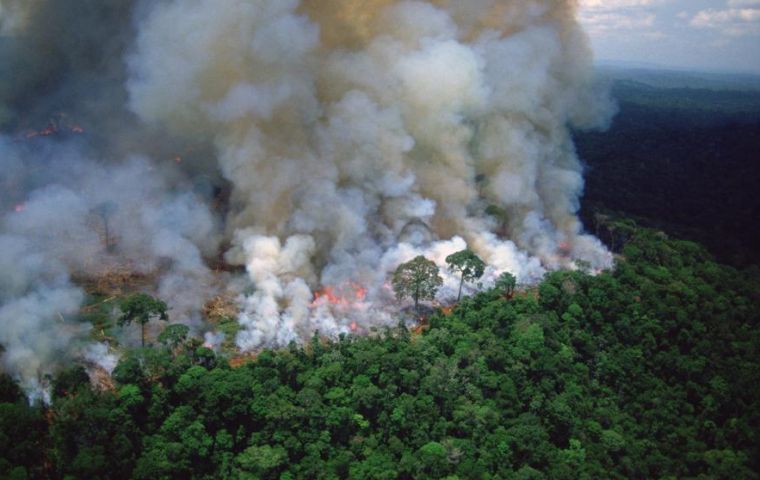MercoPress. South Atlantic News Agency
Increasing number of wildfires recorded in Amazon after new Forest Code
 Anderson also foresaw a significant increase in the outbreaks of fire in the region due to the increase in deforestation and land grabbing.
Anderson also foresaw a significant increase in the outbreaks of fire in the region due to the increase in deforestation and land grabbing. Wildfires in Boca do Acre, Amazonas, went from 66% in 2012, the year the new Forest Code was approved, to 88% in 2019, according to a report from the National Center for Monitoring and Alerts of Natural Disasters (Cemaden) published Tuesday in partnership with other organizations, Agencia Brasil reported.
The study analyzed satellite data of burned areas between 2003 and 2019, in a new frontier of deforestation, in southwest Amazonas. After cross-referencing the data, scientists weighted information about climate, land cover, rural properties, and protected areas.
According to study co-author Liana Anderson, the goal was to provide a comprehensive assessment of the spatial extent and patterns of burned areas, analyzing what, where, and how much has changed in order to better understand fires in the region.
“The project's goal is to evaluate the projections of the relationship between selective logging and forest fires for the years 2030, 2050, to understand the interconnection between these processes and the possible scenarios for this region, seeking to think of ways for the scientific data to subsidize territorial planning, public policies that allow the maintenance of forest services, conservation and sustainable development for this region,” she said.
This article is the first focused on the southwest of Amazonas and sought to diagnose both the issue of wildfires and forest fires and their relations with climatic variables such as temperature and rainfall, in addition to assessing the understanding of how these processes occur in different types of land regulation (rural properties and protected areas - conservation units and indigenous territories), she added.
The researcher also pointed out that the first interesting result was that there was a high occurrence of small areas that burn mainly in forest areas and agriculture and pasture. “In this case, we know about the use of fire for the purpose of managing these areas, but many times fire escapes into forest areas, resulting in forest fires. The extent of these burned areas doubled or tripled in size between the years 2004/2005, 2009/2010, 2015/2016. These are years when the region was affected by extreme droughts, leading to increased vulnerability of forests to forest fires,” she explained.
“This pattern during the years when there was a drought in the Amazon, influenced the productive areas of agriculture and pasture. In addition to the impacts on ecosystem services in forests affected by fire, some rural producers have suffered losses,” she went on.
“We also observed fire occurring more in the areas near the Apurinã and Boca do Acre indigenous lands, but this fire occurs within rural properties, which leads us to conclude that the presence of such rural properties on the border with protected lands ends up influencing the process of deforestation and fire itself being a vector for the entry of fire. Thus, the presence of these rural properties in this border region with protected areas influences the process of deforestation and fire as a threat vector for these areas,” Anderson also noted.
The researcher also pointed out that the survey detected an increase between 2003 and 2019 in burned areas still not regulated for a specific purpose, which were thus being degraded. “And they are public, so it also has an indication of a possible conflict of interest or a land situation that needs to be evaluated. In all cases, the information that needs to be extracted from here is that there is an urgency to evaluate and regulate these areas aiming at legal security about the type of activities that can be carried out there and to protect an asset that belongs to all Brazilians if the purpose is conservation, total preservation of this forest,” she concluded.
Anderson also foresaw a significant increase in the outbreaks of fire in the region due to the increase in deforestation and land grabbing.
(Source: Agencia Brasil)




Top Comments
Disclaimer & comment rulesCommenting for this story is now closed.
If you have a Facebook account, become a fan and comment on our Facebook Page!